The anti-immigration backlash comes to Japan
It was always bound to happen.
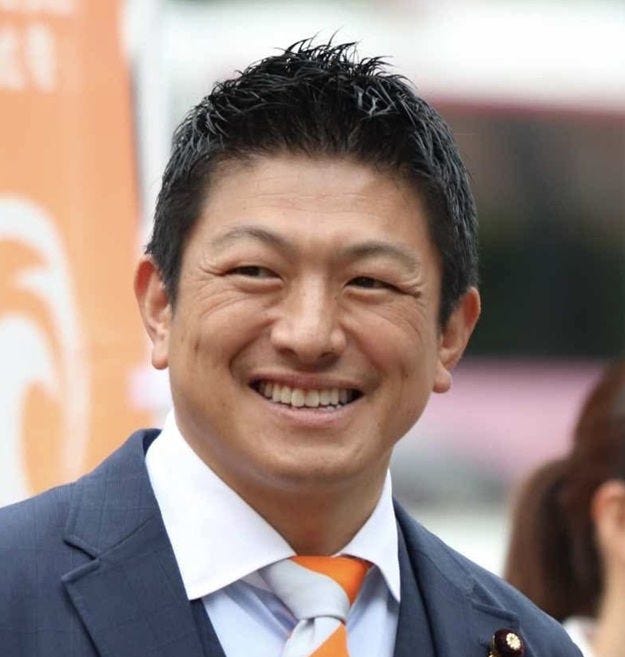
We often talk about ways in which Japan is ahead of other developed nations; in the old days, people said this about technology, while more recently it’s usually about social trends like sexless youth. But when I lived there, I often noted ways in which Japan was behind the U.S. Trends in fashion, music, and culture seemed to get popular in Japan about five to ten years after their heyday in America.1
For a long time, mainstream Japanese politics was essentially devoid of the type of xenophobic, conspiratorial, nativist populism that has defined the MAGA movement in America and parties like AfD in Europe. The late Abe Shinzo, Japan’s prime minister from 2012 to 2020, had the reputation of being a rightist. But in fact, he governed as much more of a Reaganite conservative, or sometimes even a liberal; he opened the country to immigration and supported women in the workplace. When an anti-Korean hate group arose in the early 2010s, Abe passed Japan’s first law against hate speech and put the hate group on a watch list, ultimately demolishing it as a political force.
But like raves and backwards baseball caps, Trumpian politics has finally made it to Japan’s shores. A new political party called Sanseito2 has won a surprising number of seats in Japan’s recent Upper House election, running on a platform that mostly looks like it was copied directly from MAGA:
Its leader is a former supermarket manager who…campaigned on the Trumpian message “Japanese First.”…Now Japan’s burgeoning right-wing populist party Sanseito has…bagged 14 seats [out of 248] in Japan’s upper house…
Party leader Sohei Kamiya founded the group in 2020 by “gathering people on the Internet,” then gradually began winning seats in local assemblies…It gained traction during the Covid pandemic, during which it spread conspiracy theories about vaccinations and a cabal of global elites…[I]n the run-up to the upper house elections, it became better known for its “Japanese First” campaign – which focused on complaints of overtourism and the influx of foreign residents…Sanseito tapped into these frustrations on its “Japanese First” platform, along with other complaints about stagnant wages, high inflation and costs of living…
The party supports caps on the number of foreign residents in each town or city, more restrictions on immigration and benefits available to foreigners, and making it harder to naturalize as citizens…Sanseito is also pushing for stronger security measures and anti-espionage laws, greater tax cuts, renewable energy, and a health system that leans away from vaccines.
Some of this — for example, the antivax stuff and the ranting about globalist elites — is clearly just the spread of memes from the U.S. and Europe to Japan. Kamiya Sohei, the party’s leader, even said some stuff about “Jewish capital” in a speech; Japan’s banks have essentially zero Jews in them, so you know this is just something he read on the internet.
But the party’s main issue — restrictions on immigration and tourism — isn’t just mimicry of Trump or AfD. Instead, it’s a response to a real and important trend that has affected the entire world, and happened to hit Japan a little later than other countries.
There are three main reasons for the global migration boom. The first is the internet; as people in the developing world get more information about how to move to rich countries, and learn what life in rich countries is like, a lot more of them get the idea to move. The second reason is global development; as each country first starts to escape poverty, its people get enough money to move out.3
The third reason is low fertility rates. All rich countries now have fertility rates that will cause them to dwindle and shrink in the long term. This causes labor shortages in many industries. Rather than accept large-scale economic and social disruption from labor shortages, essentially every rich country eventually chooses to turn to immigration to plug those gaps. Japan took a little longer to reach this decision, but ultimately it ended up doing much the same thing everyone else did:
If you want the detailed story of how and why Japan opened itself up to immigration, read that post. But the basic story is that Japan has, in fact, opened itself up to immigration:
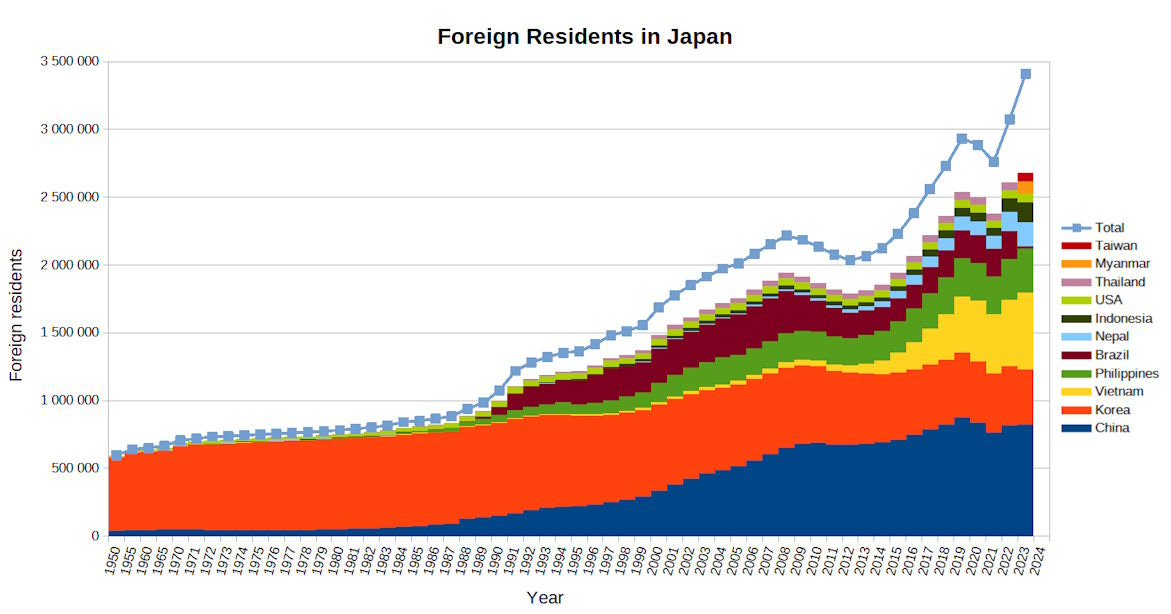
The “Korean” people on this chart are almost all “zainichi” people, whose ancestors immigrated from Korea and who have South or North Korean passports and citizenship (Japan does not have birthright citizenship), but who are functionally Japanese. The real influx of foreigners only started in the 1990s, and it was only around 2013 that true permanent mass immigration began. That immigration is mostly from Vietnam, the Philippines, and Nepal, though some other Southeast Asian countries, as well as the U.S. and Taiwan, are starting to figure into the mix as well.
I travel to Japan quite frequently, and this immigration is very noticeable. Plenty of convenience stores have Nepalese and Chinese clerks; plenty of restaurants have Vietnamese cooks. Also keep in mind that the numbers above count only the foreign-born, not the children of the foreign-born; Japan’s youth are diversifying more rapidly than the population as a whole.
In fact, it’s an open question whether this immigration will degrade some of the special characteristics that make Japan such a great place to live in the first place. Japan is not the U.S. — it’s not a nation of immigrants, and it has traditionally defined its national identity in terms of a unique culture that newcomers don’t share.
Could immigration change Japan for the worse?
Other than making it slightly harder to talk to convenience store clerks, mass immigration hasn’t yet really changed the face of Tokyo, Osaka, or other big Japanese cities. But in specific areas, immigration is forcing big local changes to Japan’s way of life. There are now over 200,000 Muslims in Japan; mosques, Muslim schools, and Muslim graveyards4 have radically reshaped some neighborhoods.
Then there’s the possibility of crime. Unlike the United States, Japan’s society functions on the assumption of almost zero violent crime. Its famously safe streets give women and children the freedom to walk around at night alone without worrying — a freedom that’s totally alien to Americans, and a constant source of wonder for people who visit Japan. The assumption of total public safety also allows cities to be built with a level of walkability and density that the crime-ridden U.S. shies away from.
Immigrants in Japan are generally surprisingly well-behaved. Unlike in the U.S., the average immigrant in Japan is going to tend to be a little more rowdy and unruly than the locals, just because Japan is one of the most peaceful countries on Earth to begin with. But acculturation is real and powerful; people tend to follow the social norms of the people around them, so when you drop a random American or Australian in the middle of urban Japan, even if he was a gangster back home, he’ll probably follow the rules like everyone else does. (In fact, I knew two such former gangsters in Osaka.)
On average, it looks like foreigners get arrested at a bit less than twice the rate of native-born Japanese people. Given the very low baseline, this isn’t a very significant amount of crime. Japan has a murder rate of about 0.23; even doubling that would still leave them safer than Korea or China (and safer than Japan when I lived there in the 2000s, for that matter), so increasing it by a far smaller percent via immigration isn’t going to change the nation’s fundamental character. Immigrant crime isn’t a big deal in Japan…yet.
But if the foreign-born population of Japan keeps growing, will this still hold true? If Japan’s population goes from 3% foreign born to 16% — the level of the UK — there will be large enclaves where foreigners and their descendants live out their lives mostly surrounded by each other instead of by Japanese people.
At that point, will acculturation to low crime rates break down? That’s probably what happened in France, where “banlieue” immigrant neighborhoods are high in crime and have seen frequent rioting, despite the overall peacefulness of the country. It would be a shame to see Japan forced to become like France, with guards armed with machine guns standing on street corners. The loss of the ability of women and children to walk safely alone at night in urban areas would be a tragedy. The scary thing here is that we don’t really know if this will happen, or how much immigration it would take to bring it about…and we won’t ever know, unless and until we wake up and find that it’s already too late.
So it’s reasonable for Japanese people to be uneasy about the possibility of continued mass immigration. In fact, although I’m personally an advocate of continued large-scale immigration in America, I’m pretty apprehensive about the prospect when it comes to Japan. And I can understand why some Japanese people are apprehensive as well.
The overtourism problem
In fact, I think there’s another reason for the rise of nativist politics in Japan: the overtourism problem.
In recent years, thanks in part to a concerted decades-long campaign by the national government, the entire world has learned that Japan is an easy place to visit and get around in. Translation apps, Google Maps, cheap international roaming, and Apple Pay have made it even easier. Japan is an incredibly unique, pleasant, and fun place, and it’s also now a cheap place for foreigners, thanks to the recent weakening of the yen. Everyone who recommends travel destinations says the same thing: Go to Japan.
As a result, Japan has become absolutely flooded with tourists. In 2024 the country probably received about 37 million travelers:
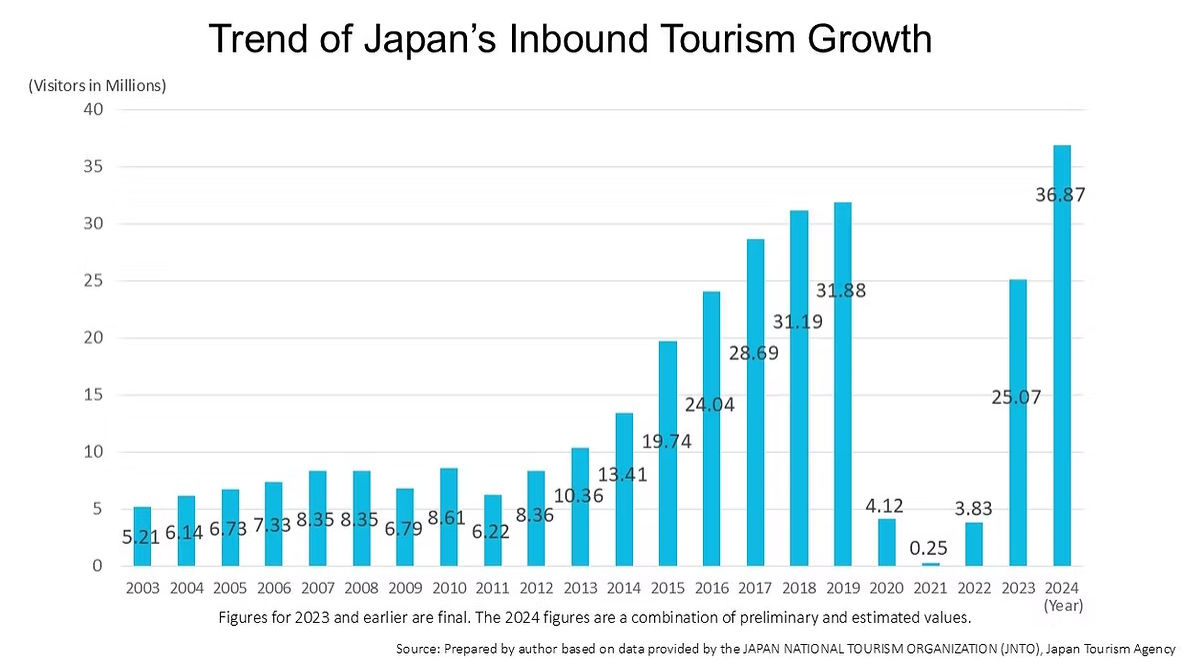
If this boom were dispersed evenly throughout time and space, it wouldn’t be very onerous. If every tourist came for only one week, and they were spread out evenly throughout the year, 37 million annual visitors would represent only 0.6% of the Japanese population. That’s tiny.
The problem is that the tourists are not spread out evenly through time and space. They crowd into a few places — the west side of Tokyo, the older neighborhoods of Kyoto — at a few times during the year. During the cherry blossom season in late March and early April, west Tokyo feels as international as NYC. The coffee shops and restaurants and parks are crammed with foreigners, few of whom can speak Japanese. Train stations are jammed up with tourists fumbling with their payment cards at the ticket gate. It’s almost impossible to get a dinner reservation.
In some neighborhoods, the crush goes away during off-season, but some of Japan’s most beautiful and vibrant spots have been hollowed out into tourist traps. Golden Gai, a small drinking district which houses some of Tokyo’s coolest little bars, is now almost entirely tourists. Shibuya, once the beating heart of Japan’s youth culture, is now a museum of itself. Akihabara is no longer the haunt of anime nerds and social outcasts, but a place where tourists go to shop at a shrinking number of increasingly generic stores.
Nowhere has it worse than Kyoto. Reeves Wiedeman had a great travel report in the Intelligencer the other day, illustrating how everything that made Kyoto interesting and distinctive has been either chased away by a constant choking throng of tourists, or crassly commercialized to sell to foreigners.
This is what economists call a “congestion externality”. If only one tourist goes to Shibuya, she can get lost in a neon wonderland; if a million tourists go to Shibuya, the neon wonderland gets replaced by something empty and tawdry, and no one gets to enjoy it.
Congestion externalities also strain the efficient public transit systems and well-designed streets for which Japan is famous. Cities are best when they’re built for continuous occupancy, but tourism is seasonal. That means if you build a train system to handle peak tourism season, it’ll be underused for much of the year. But if you build a train system to handle the average number of riders in order to maintain profitability, it’ll be unusable when the tourists come. There’s no fully satisfactory solution to this problem.
And all that is before we take tourist behavior into account. In Chicago or Philadelphia, a tourist is probably going to be less rowdy and more law-abiding than the locals; in Japan, it’s just the opposite. Tourists don’t acculturate as much as immigrants do; they haven’t been in a country long enough to know how to follow the local rules and norms.
As a result, you now see huge numbers of videos of tourists acting up in Japan. I’ll post just a few:
And of course there are all the high-profile cases of streamers going to Japan and behaving badly in order to get attention online.
This isn’t as bad as murder or theft, obviously, but it does degrade the character of a nation like Japan. The anti-foreigner anger fueling the rise of Sanseito isn’t just because of immigrants; it’s partly because of tourists.
And the real crux of the tourism problem is this: When does it end? If this were a temporary issue, it would be bearable. But Japanese people can look at places like Venice and realize that tourism isn’t a temporary phenomenon; if nothing ever gets done, the country’s Tier 1 cities are going to be theme parks for all eternity.
Cutting down on overtourism would probably go a long way toward defusing Japan’s rising anti-foreign backlash. One simple policy would be for each city to levy a surcharge on hotel reservations made to foreign bank accounts. This would allow Tokyo and Kyoto to selectively raise the price of tourism to those hot destinations, pushing international travelers out to cheaper smaller cities and rural areas where their dollars are more needed. (It would also raise revenue for the government.)
I think it would also help to arrest and punish of tourists who engage in criminally disruptive behavior. All Singapore had to do in order to get a reputation as a country that brooks no nonsense from tourists was to cane one guy for vandalism.
Japan needs immigrant selectivity and active assimilation policy
But cutting down on overtourism won’t solve the whole problem. Japan is simply not traditionally a nation of immigrants, and so learning how to deal with mass immigration is going to be a bumpier road than it was for the U.S. (And note that even for the U.S., it was often bumpy indeed…like now.)
Fortunately, Japan has some time. Anger at immigration has not yet come to dominate the national mood. Polls still show very favorable sentiment toward immigration. Here’s one from 2024, showing that pro-immigration sentiment has actually increased in recent years:
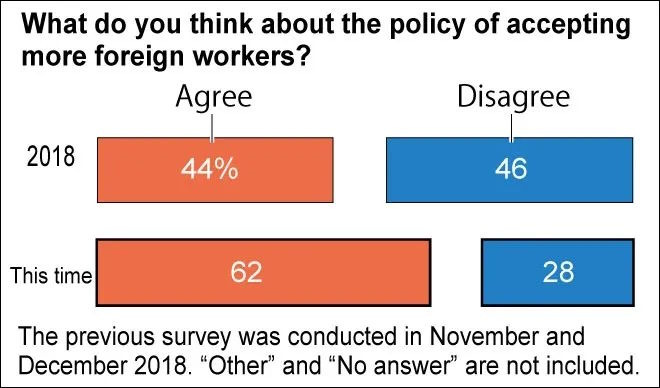
So the Sanseito backlash is still among a minority of Japanese people. But as we’ve seen with MAGA in the U.S., a minority of very dedicated, angry people can create a lot of trouble for a country.
Japan’s ruling LDP is going to have to act. Traditionally, the LDP wins by being ideologically flexible and addressing the concerns of the electorate as they arise. It needs to do so again, so that the immigration problem doesn’t end up causing the rise of a Trump-like figure.
The first thing Japan’s leaders should do is to improve immigrant selectivity. The country has struggled to attract skilled immigrants en masse, due to low entry-level salaries and the language barrier. But the government should redouble its efforts — as the U.S. becomes a less attractive destination, Japan may emerge as an attractive alternative. In fact, this is one of the main topics of my recent book, Weeb Economy. (Sadly, the book is only available in Japanese.)
But skills aren’t the only kind of selectivity. Japan can selectively target immigration from countries that are culturally and religiously similar to itself — places like Vietnam and Thailand. It can try to attract political dissidents from China, and refugees from the Hong Kong crackdown.
The second thing Japan should do is to improve assimilation policy. Japan’s system for dealing with immigrants was built on the assumption that they were temporary expats or guest workers who would eventually go back to their home countries. The children of foreigners often attend their own schools, and some of them end up with limited Japanese ability.
This has to end. Kids born to foreigners in Japan should be sent to Japanese schools, so that they learn the language, and — even more importantly — so they acculturate to the norms of the Japanese kids around them. The only kids who go to international school should be those whose parents intend to leave soon.
It’s also worth looking at the idea of residential dispersal, in order to prevent the formation of ethnic enclaves that resist Japanese culture. Singapore does this by enforcing racial diversity within each apartment block. Japan probably doesn’t have the ability or the will to go that far, but Sanseito’s idea of capping the foreign percentage in each municipality could actually be on to something. Such a cap is unworkable, of course. But the government could certainly offer vouchers for foreigners to live in neighborhoods where they’re scarce, thus helping to speed up assimilation. Japan could also act to break up poor immigrant enclaves, like Denmark does.
One other idea I had was for the Japanese government to provide free intensive Japanese language classes for all immigrants who intend to settle in Japan. These classes would also function as networking events; Japanese speakers and conversation partners could be invited to the classes. This could be matched by industry — Japanese engineers could come meet immigrant engineers, and so on. This would help immigrants build up their native connections in Japan, and to more quickly become embedded into Japanese society.
Anyway, unless Japan decides to reverse course and shut out immigrants — which would have negative consequences for its economy — it’s going to have to learn to assimilate the ones who do come and settle down. European countries are already trending strongly in this direction; Japan doesn’t have to copy their policies, but it can certainly learn some lessons from observing the Europeans’ efforts.
In any case, I don’t expect Trump-style policies to prevail in Japan. Sanseito is unlikely to become Japan’s main opposition party, much less take over the country. But Japan’s leaders should display their traditional nimbleness, and act to defuse the main source of anger behind Sanseito’s rise, before the issues get even harder to handle.
In fact, there’s a long and storied history of cultural transmission and retransmission back and forth between the U.S. and Japan. The best book about this subject is W. David Marx’s Ametora, which deals with men’s fashion.
The name technically means the Political Participation Party, though I think “Populist Party” might be a better translation. It’s also a pun on the word “agree”, so when you hear it, it sounds like “the party you agree with”. Clever!
Eventually, when the country gets rich enough that moving out is a bad economic proposition, emigration trails off.
Traditionally, Japanese graveyards are very compact, because Japan cremates everyone. Religious Muslims refuse to cremate bodies, requiring much more land for graves; in a country as space-constrained as Japan, this can become a major problem very quickly!


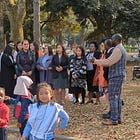
As someone who loves traveling to Japan, *please* tax me for it. Don’t let it being awesome ruin itself through tourist volume! Particularly for the Tokyo/Osaka/Kyoto trio. I would happily pay more and help Japanese society out a bit. Congestion pricing works, take the money and do something useful with it.
Free language classes aren’t, themselves, a garanter of fluency or integration: Sweden’s been offering them for decades, but the classes are only as good as the teacher (who are often terrible or just phoning it in) and they’re predicated on the assumption that immigrants will attend language schooling full-time for 12-18 months upon arrival, instead of, you know… working.
Which isn’t really something that makes sense for the higher-skill immigrants you might want to attract, especially as cost-of-living makes it pretty unrealistic to go without income for a year or two! To accommodate those folks, you need weekend and after-hours courses and remote learning, which are, of course, logistically challenging to organize.
The idea of making the courses dual-use as networking with locals seems great, in theory, but how would this actually work in practice? Japanese professionals are famously overworked already! Why would they give of their precious little free time to hand-hold some foreigners? Swedes don’t work as much and immigrants basically don’t exist to them, except as a problem, occasionally. There’s certainly no cosmopolitan networking occurring at these language classes or in any other mediated setting!
It seems more feasible that there could be on-the-job mentorships or programs for companies motivated by a labor shortage wherein the mentors were actually incentivized to do it. Maybe pair that with subsidized language programs on-site at companies after hours?
I don’t think a lot of integration policies or initiatives—in Europe, in particular—are really gamed out very rigorously, and the devil is really in the details. The programs that exist tend to put the responsibility/blame on the troublesome foreigner for learning a rote version of local cultural norms, a grab-bag of civic facts, and some language—but little is asked of the hosts. And what motivation do locals have to step up? And that’s even true for the people whose job it is! As stated, though many of the professional language teachers are motivated and engaging, many and perhaps most aren’t—the role is genuinely tough and the pay/status is low so the simple majority are treating it like “just another service sector job,” like maybe working as an eldercare aid. So these challenges would need to be addressed realistically to actually execute on such a program with positive outcomes.